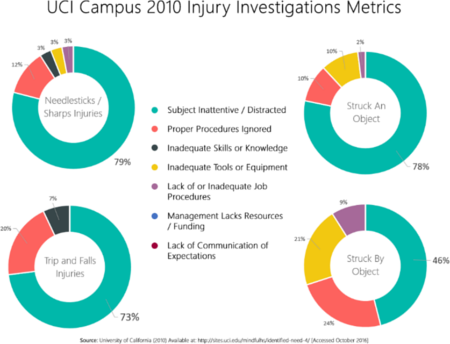In part one of this article, we covered quite a lot – what mindfulness is, why it’s relevant to EHS, and where, as humans, we have the most control over our lives. Moving on from distractions and reactions, here we’re going to look at solutions.
To recap, 73% of slips, trips and falls are caused by the subject being distracted (see Figure 1). A distraction of just 2.8 seconds doubles the likelihood of error. The human attention span is now apparently less than that of a goldfish, with top distractions at work being time pressures, complacency and ‘life.’
Where does mindfulness fit in? Mindfulness increases the ability to focus solely on one task, gives us space between our emotions and reactions, and helps us subsequently control those reactions to avoid an inappropriate or knee-jerk response. Mindfulness has been incorporated by some of the world’s most successful companies into their culture, with General Mills reporting 80% of senior executives experiencing a positive change in their ability to make decisions after introducing mindfulness to their lives. Better yet, 89% felt they had become better listeners.
 For EHS, it’s about improving workers’ ability to concentrate on the task at hand whilst simultaneously encouraging them to – when they have time – take 15 minutes to go a walk, go to a quiet place, and pay attention to themselves. The aim is to reduce the statistic that tells us almost a quarter of the most frequent workplace incident – slips, trips and falls – are caused by distraction or inattentiveness.
For EHS, it’s about improving workers’ ability to concentrate on the task at hand whilst simultaneously encouraging them to – when they have time – take 15 minutes to go a walk, go to a quiet place, and pay attention to themselves. The aim is to reduce the statistic that tells us almost a quarter of the most frequent workplace incident – slips, trips and falls – are caused by distraction or inattentiveness.
Now, it’s a saying we’re all familiar with in EHS: safety is a top-down process. Mindfulness, too, should start with you. Although challenges in the day of a senior manager or director are different to those faced on the shop-floor, the overall message is constant. Identify distractions and manage reactions. Mindfulness is how you get there.
Solutions – Part 2
Across an organization, there could be four processes of mindfulness:
- Preoccupation of failure – being vigilant
- Reluctance to simplify – embrace complex procedures without taking shortcuts
- Sensitivity to operations – encouraging workers to notice and report even the smallest things
- Commitment to resilience and deference to expertise – know when to hand the situation over to a decision-maker
A helpful and, some would say, essential aspect to mindfulness is concentrating on your breathing – we’re constantly told to “breath” throughout our lives whenever our emotions run amok but do any of us really do it? I mean really concentrate on it. You might be thinking “I’m too busy to sit quietly paying attention to my breathing or to practice mindfulness.” So doesn’t that make practicing mindfulness all the more important, when just 15 minutes a day can lead to getting more done in less time?
How to do nothing
If you read the first article in this series you’ll have thought about my question (hopefully, if you weren’t too busy): when was the last time you did absolutely nothing? Unfortunately this article is not a dialogue and I can’t hear you, but I can give you my answer. I don’t know. We’ve forgotten how to do nothing. Here’s another great TED talk on… nothing.
However, asking the question of whether we really are so busy these days, Laura Vanderkam, author of numerous time management and productivity books, reminds us:
“The sheer volume of modern distractions may make life feel busier than it is. Constantly trying to do two things at once means you can feel pulled in multiple directions. You can be working a regular 40-hour-per-week job, and check work email five times at night while eating dinner or watching TV. At just two minutes at a pop, that adds a mere 10 minutes of work, but can pollute whole hours.”
The key? Make distractions less distracting.
You might have caught me out this point – I’m telling you to do nothing, at the same time as telling you to wholly concentrate on whatever you’re doing. Confusing. Doing nothing is good practice for becoming mindful, getting better at being ‘present’ and focusing, blocking out whatever else is whizzing round your head. If, according to a Harvard research paper, our minds are lost in thought a staggering 47% of the time, it’ll take work to get there.
You could start out by practicing mindfulness by taking life one task at a time and giving it your undivided attention. Be that task reading, driving, welding, walking, observing a procedure, operating machinery or even thinking. In the present moment, take notice – be mindful – of yourself and your senses.
Mastering self-management
Richard Hawk, professional speaker on health and safety, suggests listing plans for the day on a desktop note and allocating time to each task. Set a timer, and only concentrate on that one task. Don’t check your emails or look at your phone. “Even if you do this only once a day (or once every couple of days), you’re again honing your focusing skills. Practice creates proficiency. And I’m sure that with enough practice not only will you be a Marvelous Multitasker, but eventually you’ll also be a Fabulous Focuser!”
Mindfulness also goes for safety culture – be reflective and not reactive. In an organization, it’s important that management spends time reflecting on incidents rather than facilitating a blame culture or a “just get it done” mindset, or one where an incident is corrected and then forgotten about. Consider your department's reaction carefully in order to facilitate the most productive outcome.
Encourage employee wellness
A healthier, happier worker tends to better handle job stress and stay focused on the risks involved in tasks at work.
Promoting a happy workforce doesn’t have to connote pay incentives, ‘team building’ days, or even organizing celebrations (although the promise of pizza did boost productivity by 6.7% in this study). Encourage employees to take a walk during their lunch break. It’s a cost-free program that has previously seen employees become healthier, happier and miss less time from work.
You could even plan monthly workshops in which employees learn new ways to practice mindfulness. The sample is of a young audience, but if 97% of freshman students who took a mindfulness course recommended it to others, surely the movement must be doing something right? A mindfulness course is something that General Mills invested in, resulting in the promising statistics I mentioned earlier.
Make it a habit
Stagger it – don’t overload yourself or workers with changes. Referring back to Schwartz on the NY Times who I also quoted in the first article, “The problem is that we humans have a very limited reservoir of will and discipline. We’re far more likely to succeed by trying to change one behavior at a time, ideally at the same time each day, so that it becomes a habit, requiring less and less energy to sustain.”
Maybe at 12PM every day for 21 days (the length of time it takes for something to become routine) you leave your desk for a 5 minute wander around the building. The following two weeks you could leave the building for 10 minutes, and then four weeks later you could be sitting on the grass at your local park for 15 minutes at lunch, calmly acknowledging and accepting your feelings, thoughts, and sensations. You’ll be pleasantly surprised at how your concentration at work improves as a result.
Mindfulness in everyday life
The man who brought mindfulness into mainstream US culture in 1979, Jon Kabat-Zinn speaks about mindfulness being “presence of heart.” He explains that being in the present moment has become so hard for humans because the present moment is never perfect. We decide instead to look forward to something in the future, be it the weekend or a holiday. But even then these future moments become imperfect when they come to present, because there are numerous distractions. Then we’re always looking forward, and never concentrating fully on the here and now – and aren't we all far too familiar with the saying "Where has the time gone?"
To Jon and to Western culture, mindfulness is “The awareness that arises through paying attention on purpose in the present moment, and non-judgmentally.” Bringing mindfulness to EHS is not a silver bullet in keeping workers safe, rather a scientifically proven method of achieving awareness and concentration – undeniably important factors in high risk work, management and everyday life.
To me, there are three factors to mindfulness that are important in EHS:
- The increased ability to tune out distractions around you, decreasing the risk of error
- Learning how to control your reactions, avoiding knee-jerk or unhelpful responses
- Concentrating on the present moment to reduce stress and improve wellbeing (remember the H in EHS!)
In a sentence, don’t lose touch with who’s doing the doing. Deliberately experiencing a situation could be the difference between an accident and a job well done, frustration and a great idea, or, more philosophically, regret and satisfaction.
Source:
Pro-Sapien Software Ltd.
www.pro-sapien.com



